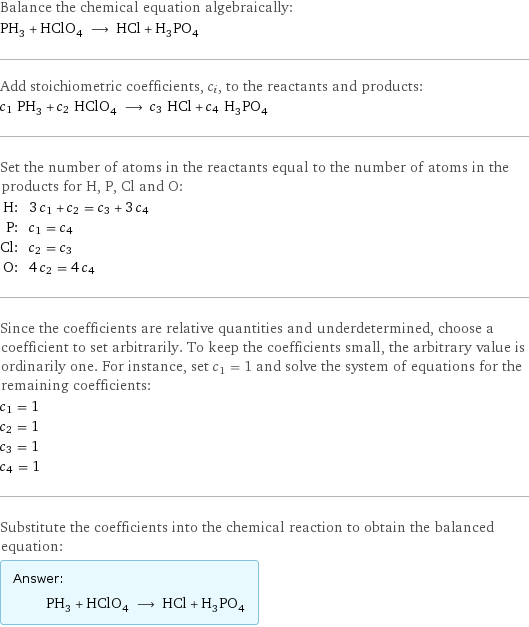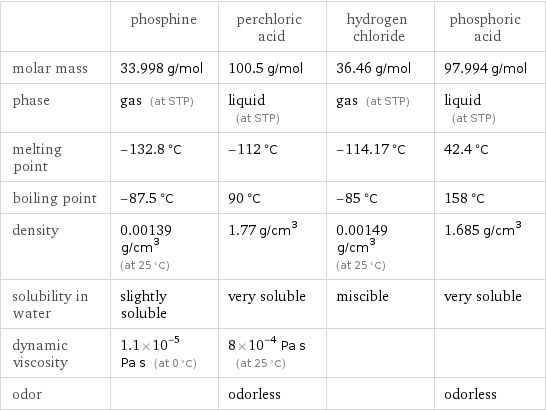Input interpretation

PH_3 phosphine + HClO_4 perchloric acid ⟶ HCl hydrogen chloride + H_3PO_4 phosphoric acid
Balanced equation

Balance the chemical equation algebraically: PH_3 + HClO_4 ⟶ HCl + H_3PO_4 Add stoichiometric coefficients, c_i, to the reactants and products: c_1 PH_3 + c_2 HClO_4 ⟶ c_3 HCl + c_4 H_3PO_4 Set the number of atoms in the reactants equal to the number of atoms in the products for H, P, Cl and O: H: | 3 c_1 + c_2 = c_3 + 3 c_4 P: | c_1 = c_4 Cl: | c_2 = c_3 O: | 4 c_2 = 4 c_4 Since the coefficients are relative quantities and underdetermined, choose a coefficient to set arbitrarily. To keep the coefficients small, the arbitrary value is ordinarily one. For instance, set c_1 = 1 and solve the system of equations for the remaining coefficients: c_1 = 1 c_2 = 1 c_3 = 1 c_4 = 1 Substitute the coefficients into the chemical reaction to obtain the balanced equation: Answer: | | PH_3 + HClO_4 ⟶ HCl + H_3PO_4
Structures

+ ⟶ +
Names

phosphine + perchloric acid ⟶ hydrogen chloride + phosphoric acid
Equilibrium constant
![Construct the equilibrium constant, K, expression for: PH_3 + HClO_4 ⟶ HCl + H_3PO_4 Plan: • Balance the chemical equation. • Determine the stoichiometric numbers. • Assemble the activity expression for each chemical species. • Use the activity expressions to build the equilibrium constant expression. Write the balanced chemical equation: PH_3 + HClO_4 ⟶ HCl + H_3PO_4 Assign stoichiometric numbers, ν_i, using the stoichiometric coefficients, c_i, from the balanced chemical equation in the following manner: ν_i = -c_i for reactants and ν_i = c_i for products: chemical species | c_i | ν_i PH_3 | 1 | -1 HClO_4 | 1 | -1 HCl | 1 | 1 H_3PO_4 | 1 | 1 Assemble the activity expressions accounting for the state of matter and ν_i: chemical species | c_i | ν_i | activity expression PH_3 | 1 | -1 | ([PH3])^(-1) HClO_4 | 1 | -1 | ([HClO4])^(-1) HCl | 1 | 1 | [HCl] H_3PO_4 | 1 | 1 | [H3PO4] The equilibrium constant symbol in the concentration basis is: K_c Mulitply the activity expressions to arrive at the K_c expression: Answer: | | K_c = ([PH3])^(-1) ([HClO4])^(-1) [HCl] [H3PO4] = ([HCl] [H3PO4])/([PH3] [HClO4])](../image_source/f118cc39484470aef4249a5b33356545.png)
Construct the equilibrium constant, K, expression for: PH_3 + HClO_4 ⟶ HCl + H_3PO_4 Plan: • Balance the chemical equation. • Determine the stoichiometric numbers. • Assemble the activity expression for each chemical species. • Use the activity expressions to build the equilibrium constant expression. Write the balanced chemical equation: PH_3 + HClO_4 ⟶ HCl + H_3PO_4 Assign stoichiometric numbers, ν_i, using the stoichiometric coefficients, c_i, from the balanced chemical equation in the following manner: ν_i = -c_i for reactants and ν_i = c_i for products: chemical species | c_i | ν_i PH_3 | 1 | -1 HClO_4 | 1 | -1 HCl | 1 | 1 H_3PO_4 | 1 | 1 Assemble the activity expressions accounting for the state of matter and ν_i: chemical species | c_i | ν_i | activity expression PH_3 | 1 | -1 | ([PH3])^(-1) HClO_4 | 1 | -1 | ([HClO4])^(-1) HCl | 1 | 1 | [HCl] H_3PO_4 | 1 | 1 | [H3PO4] The equilibrium constant symbol in the concentration basis is: K_c Mulitply the activity expressions to arrive at the K_c expression: Answer: | | K_c = ([PH3])^(-1) ([HClO4])^(-1) [HCl] [H3PO4] = ([HCl] [H3PO4])/([PH3] [HClO4])
Rate of reaction
![Construct the rate of reaction expression for: PH_3 + HClO_4 ⟶ HCl + H_3PO_4 Plan: • Balance the chemical equation. • Determine the stoichiometric numbers. • Assemble the rate term for each chemical species. • Write the rate of reaction expression. Write the balanced chemical equation: PH_3 + HClO_4 ⟶ HCl + H_3PO_4 Assign stoichiometric numbers, ν_i, using the stoichiometric coefficients, c_i, from the balanced chemical equation in the following manner: ν_i = -c_i for reactants and ν_i = c_i for products: chemical species | c_i | ν_i PH_3 | 1 | -1 HClO_4 | 1 | -1 HCl | 1 | 1 H_3PO_4 | 1 | 1 The rate term for each chemical species, B_i, is 1/ν_i(Δ[B_i])/(Δt) where [B_i] is the amount concentration and t is time: chemical species | c_i | ν_i | rate term PH_3 | 1 | -1 | -(Δ[PH3])/(Δt) HClO_4 | 1 | -1 | -(Δ[HClO4])/(Δt) HCl | 1 | 1 | (Δ[HCl])/(Δt) H_3PO_4 | 1 | 1 | (Δ[H3PO4])/(Δt) (for infinitesimal rate of change, replace Δ with d) Set the rate terms equal to each other to arrive at the rate expression: Answer: | | rate = -(Δ[PH3])/(Δt) = -(Δ[HClO4])/(Δt) = (Δ[HCl])/(Δt) = (Δ[H3PO4])/(Δt) (assuming constant volume and no accumulation of intermediates or side products)](../image_source/c247fb95df730c083c02a14455007323.png)
Construct the rate of reaction expression for: PH_3 + HClO_4 ⟶ HCl + H_3PO_4 Plan: • Balance the chemical equation. • Determine the stoichiometric numbers. • Assemble the rate term for each chemical species. • Write the rate of reaction expression. Write the balanced chemical equation: PH_3 + HClO_4 ⟶ HCl + H_3PO_4 Assign stoichiometric numbers, ν_i, using the stoichiometric coefficients, c_i, from the balanced chemical equation in the following manner: ν_i = -c_i for reactants and ν_i = c_i for products: chemical species | c_i | ν_i PH_3 | 1 | -1 HClO_4 | 1 | -1 HCl | 1 | 1 H_3PO_4 | 1 | 1 The rate term for each chemical species, B_i, is 1/ν_i(Δ[B_i])/(Δt) where [B_i] is the amount concentration and t is time: chemical species | c_i | ν_i | rate term PH_3 | 1 | -1 | -(Δ[PH3])/(Δt) HClO_4 | 1 | -1 | -(Δ[HClO4])/(Δt) HCl | 1 | 1 | (Δ[HCl])/(Δt) H_3PO_4 | 1 | 1 | (Δ[H3PO4])/(Δt) (for infinitesimal rate of change, replace Δ with d) Set the rate terms equal to each other to arrive at the rate expression: Answer: | | rate = -(Δ[PH3])/(Δt) = -(Δ[HClO4])/(Δt) = (Δ[HCl])/(Δt) = (Δ[H3PO4])/(Δt) (assuming constant volume and no accumulation of intermediates or side products)
Chemical names and formulas

| phosphine | perchloric acid | hydrogen chloride | phosphoric acid formula | PH_3 | HClO_4 | HCl | H_3PO_4 Hill formula | H_3P | ClHO_4 | ClH | H_3O_4P name | phosphine | perchloric acid | hydrogen chloride | phosphoric acid
Substance properties

| phosphine | perchloric acid | hydrogen chloride | phosphoric acid molar mass | 33.998 g/mol | 100.5 g/mol | 36.46 g/mol | 97.994 g/mol phase | gas (at STP) | liquid (at STP) | gas (at STP) | liquid (at STP) melting point | -132.8 °C | -112 °C | -114.17 °C | 42.4 °C boiling point | -87.5 °C | 90 °C | -85 °C | 158 °C density | 0.00139 g/cm^3 (at 25 °C) | 1.77 g/cm^3 | 0.00149 g/cm^3 (at 25 °C) | 1.685 g/cm^3 solubility in water | slightly soluble | very soluble | miscible | very soluble dynamic viscosity | 1.1×10^-5 Pa s (at 0 °C) | 8×10^-4 Pa s (at 25 °C) | | odor | | odorless | | odorless
Units
